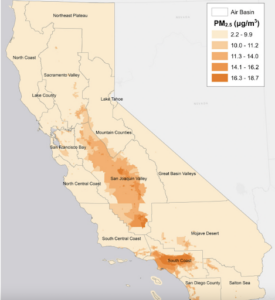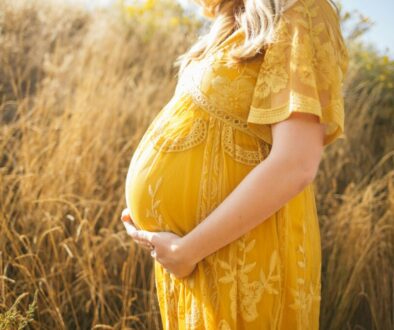Air pollution can raise risk of Covid-19 death 51%, study says
By Pam Strayer
People who are live in areas that come with long-term exposure to high levels of air pollution face a 51% higher chance of dying from Covid-19, and thousands of lives could have been saved during the pandemic if air quality standards were met, a new public health research study has found.
The study, which focused on California residents, is the latest of several exploring the impacts of air pollution on the incidence and severity of Covid-19 infections. And the research adds to a growing body of global research highlighting the importance of reducing air pollution for overall health.
The researchers determined that 9%, or at least 4,250 Covid-19 deaths, could have been prevented if California met national air quality standards.
The most vulnerable people in terms of air pollution exposure were likely to be Latinos and those living in low-income areas, the researchers found.
The study, published in Environmental Advances, was authored by Paul English, director of the Public Health Institute’s “Tracking California” program, along with ten other researchers, including some affiliated with the University of California San Francisco (UCSF) department of medicine and the UCSF department of epidemiology and biostatistics.
“People of color live in communities that have some of the worst air pollution, and also have greater chances of getting sick and even greater chances of dying from COVID,” English said in a release announcing the study.
“This is really concerning, especially in regions like the San Joaquin Valley where wildfires are occurring right now and contributing to greater air pollution. We can save lives by making sure families and schools have access to free and low-cost air cleaners, and that outdoor workers receive paid time off and adequate personal protection during high-pollution events like wildfires,” English stated in the release.
Vehicle emissions, including from commuters and from farm machinery in agricultural areas, were big contributors to the harmful air pollution, according to English. Dust from agricultural areas is also a factor, he said in an interview.
Farmworkers and other outdoor workers are particularly vulnerable to the dangers of the pollution, he said.
Wide range of air quality
The authors examined data for 3.1 million SARS-CoV-2 infections and 49,691 COVID-19 deaths in California from February 2020 to February 2021, looking at where the people infected with the respiratory disease lived.
The study found that people living in the highest quintile of long-term exposure to air pollution – defined as particulate matter less than 2.5 pm in diameter (PM2.5) – had a 20% higher risk of contracting Covid-19 compared to people living in the lowest quintile.
The researchers said that for those people living in those highest exposure areas, the risk of death from COVID-19 was 51% higher when compared to people living in the lowest exposure areas.
PM2.5 describes fine inhalable particles that can lodge in the lungs and pass into the bloodstream, potentially also impacting an individual’s heart.
English said that while conducting the research, the study team saw a striking difference in the wide range of air quality in the state.
 “When you compare the areas that have the cleanest air, the air quality is up to nine times [900 percent] better than in dirty air areas,” he said. The worst areas for air pollution were the San Joaquin Valley and the South Coast air basin, he said.
“When you compare the areas that have the cleanest air, the air quality is up to nine times [900 percent] better than in dirty air areas,” he said. The worst areas for air pollution were the San Joaquin Valley and the South Coast air basin, he said.
Looking across the US, the ramifications literally translate to life and death.
“There’s probably 140,000 total deaths due to outdoor air pollution in the US,” said English. “If you say California is about 10% of that, that’s 14,000 deaths due to air pollution each year.”
“Already compromised”
Jose Luis Velez, founder of the southern California-based environmental justice group Comite Civico Del Valle, said the statistics resonated with his experience of the pandemic.
“It’s a bad combination when you have a virus that attacks your respiratory system and your respiratory system is already compromised,” said Velez. “People aren’t understanding how deadly air pollution is. It’s out of control. We can’t just continue to ignore these issues. Our families, our kids, are getting sick. We have more respiratory problems than ever before.”
In Imperial County, where 85 percent of residents are Hispanic, there were 5,255 deaths from Covid-19 per million compared to 2,390 deaths per million statewide, according to the Centers for Disease Control and Prevention.
English said Imperial County was a “really highly polluted area with particulate matter.”
About 15.1% of Imperial County residents are affected by asthma and the county has twice as many pediatric, asthma-related emergency room visits and hospitalizations compared to the state’s average, according to a 2021 study by the University of California, Riverside, California.
In 2009, Comite Civico Del Valle sued the EPA for its failure to hold the county accountable for federal air standards compliance. “They let the county go on and drag their feet and never put together a plan of how they’re going to get to compliance,” he said. The suit was settled in 2010.
The California Air Resources Board (CARB) commissioned the new study to get a detailed picture of the specific risks for people living in California, which ranks worst in air pollution in the nation.
The data should help inform new policies, said Bonnie Holmes, chief of the CARB health and exposure assessment branch.
“These studies underscore the critical importance of our air pollution control work, and that is the big policy implication,” she said.
California’s recent move to prohibit the sale of new gasoline-powered cars by 2035 should help reduce air pollution, but will not solve the problem.
The new study concludes with a warning: “With the growing evidence from studies worldwide that suggest there is additional risk of COVID-19 morbidity and mortality associated with air pollution, reducing concentrations of air contaminants is now even more critical to protecting public health,” the study concludes.
 EWG
EWG


